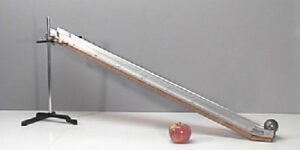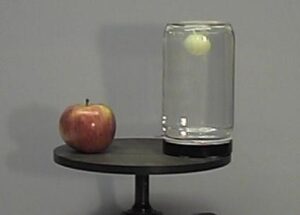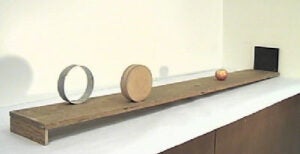M.13(1) – Moment of Inertia of a Disk and a Ring
A wooden disk and a metal ring with the same diameter (15 cm) and equal mass (605 g) roll with different accelerations down an inclined plane. One can show that the ring and the disk have the same diameter by superpostion and the same mass by placing them on a balance. Now, if both are rolled along the lecture bench by being given an equal impulse, the metal ring will continue to roll longer than the disk because of its greater moment of inertia. However, when the ring and disk are released simultaneously from the same height on an inclined plane, the wooden disk reaches the bottom first due to its lesser moment of inertia.
M.13(2) – Rolling and Sliding – Energy of Rotation
The track used in this demonstration is mounted on a wooden board. It consists of an aluminum wide strip covering the board and two parallel sides a little wider than the ball used. One end of the track is clamped to heavy stands forming an inclined plane and it is set on the edge of a table. The ball is released twice from the top of the track. First, it is allowed to rotate — just release it. On the second time, it slides down the plane — the rotational movement can be inhibited by pulling out two small rods mounted on the sides of the ball, like wings, and setting it on the track. The “wings” should hold to the sides of the track. The whole class will see that when the ball does not rotate, it jumps further away from the table than when it rotates down the track.

M.13(3) – Hinged Stick and Falling Ball
The free end of a falling hinged stick (a narrow board) falls faster than a free-falling ball placed at the other end of the stick, when their center of mass accelerates at an equal rate.
The apparatus is one meter long and consists of two wooden boards mounted one above the other and hinged together at one end. With the apparatus on a flat surface, hold the upper board at about 45°. Set the ball on the support and let the board go. The ball will end up in the plastic cup, when the two boards are sitting together.

M.13(4) – The Abberant Candle Flame
The apparatus is a wooden platform (40 cm long and 6 cm wide) connected at its center to a variable speed rotator with a clear plastic cylinder (8 cm tall and 5 cm in diameter) at each end. Inside each cylinder, there is a candle. With the platform still and the candle lit, the flames are vertical. When the platform begins rotation around its central axis, the flames begin to slant inwards pointing towards each other.
M.13(5) – Moment of Inertia Apparatus
This set-up consists of two apparently identical disks, with the same mass but with a different mass distribution: one has a massive center and the other a massive outer ring.
A thread is wound around each axis and extended over a pulley to support a weight. As one lets the weights drop, the disk will spin around their axes: the disk with a massive outer ring has a larger moment of inertia, thus rotating slower than the plastic one.

M.13(6) Accelerometer
A jar has a Styrofoam ball attached to its lid by a short cord. The ball becomes a buoyant pendulum when the jar is filled with glycerin and inverted. Hold the jar in front of you and walk quickly across the lecture room. At first the ball will move forward in the direction of acceleration, and then returns to the vertical position when your velocity becomes constant. When you slow down, the ball will move back towards you, showing deceleration. Now set the jar on the turntable and spin it. The ball moves towards the center, showing the radially inward uniform circular acceleration. The buoyant pendulum leans in the direction of the acceleration as the jar sits on the spinning turntable.



